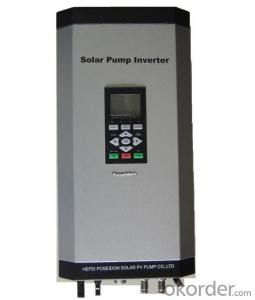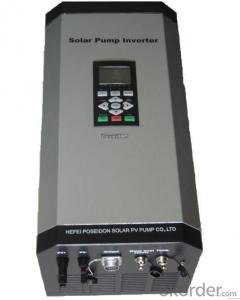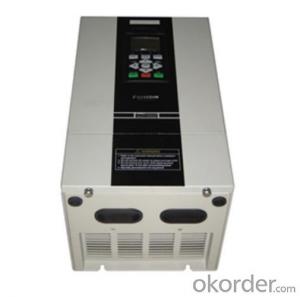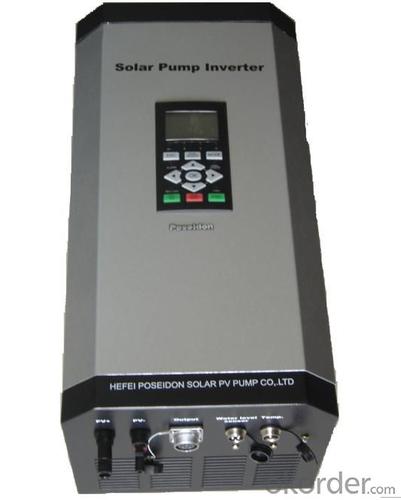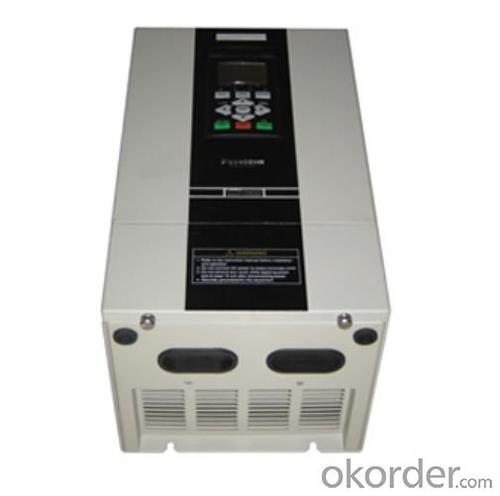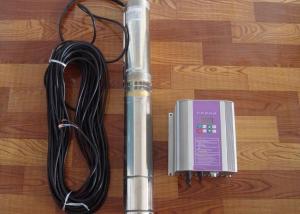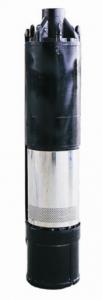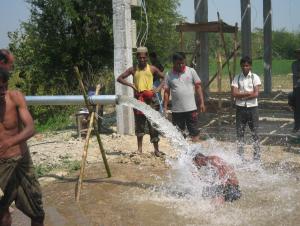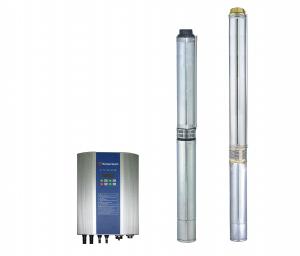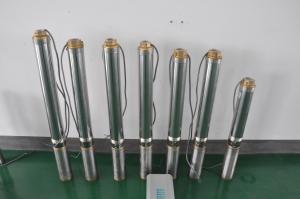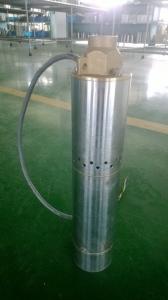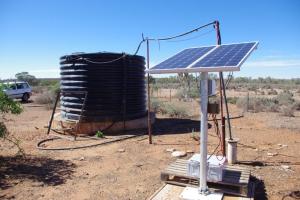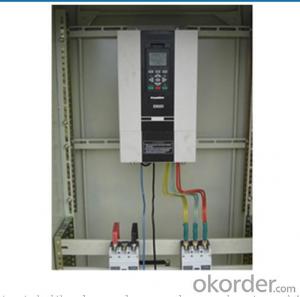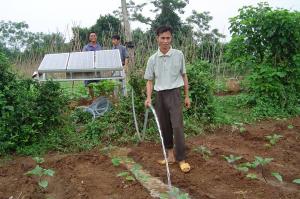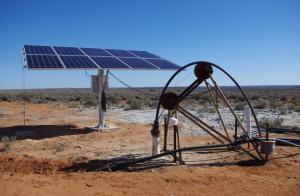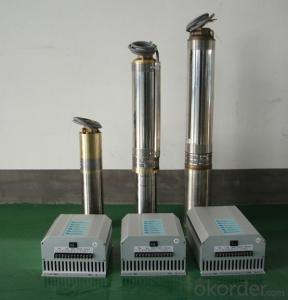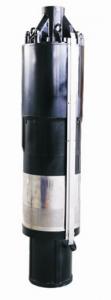Pond Solar Pump FCPM3KWH Inverter
- Loading Port:
- China Main Port
- Payment Terms:
- TT OR LC
- Min Order Qty:
- -
- Supply Capability:
- -
OKorder Service Pledge
Quality Product, Order Online Tracking, Timely Delivery
OKorder Financial Service
Credit Rating, Credit Services, Credit Purchasing
You Might Also Like
Solar pump inverter FCPM3KWH Product Description:
Product Description:
Solar water pumping system is constructed with solar panel array,solar pump inverter and AC water pump, DC current produced from solar panel will be delivered to solar pump inverter,and it will convert it into AC current to drive water pump,and will automatically regulate output frequency according to sun radiance intensity,maximally realize MPPT tracking function.
Product Features
Adopting the proposed dynamic VI maximum power point tracking (MPPT) control method, with fast response, and reliable operation, achieves efficiency of 99%.
Designed with variable frequency driver, greatly improves efficiency
Extremely high efficiency
Digital mode control, with automatic operation and manual operation mode options
Complete protection functions
Adopts intelligent IPM module, with high reliability
LCD display and operation panel, in real time presents operating data
Optional for water level measurement and control circuit
Applicable for general ACC pumps, like centrifugal pump, piston pump etc.
Independent intellectual property; Highly effective, the redundant reliability, exempts the maintenance and the long life.
The pumps are soft started, fully protected.
No batteries are used. So better Sunlight, more water
Datasheet.
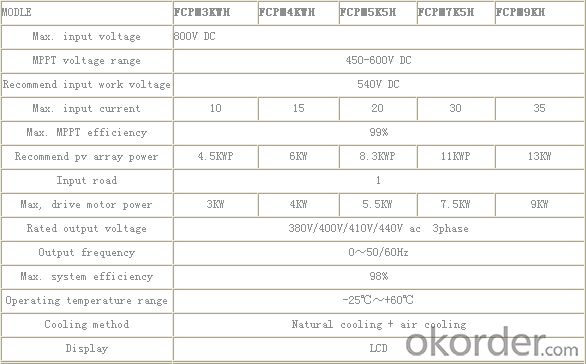
- Q: How does the angle and orientation of solar panels affect the performance of a solar pump?
- The performance of a solar pump is greatly affected by the angle and orientation of the solar panels. The angle determines the amount of sunlight received, while the orientation dictates the direction the panels face. Efficiency of solar panels is determined by the angle at which they are installed, as this affects the amount of sunlight they can capture. Sunlight is converted into electricity by solar panels, and the tilt angle determines the quantity of sunlight captured. The optimal angle is dependent on the geographical location of the solar pump. For example, regions near the equator benefit from a flat or low tilt angle to maximize sun exposure year-round. Conversely, higher latitudes require a steeper tilt angle to compensate for lower sunlight intensity. Orientation refers to the direction solar panels face, usually either south or north depending on the hemisphere. In the Northern Hemisphere, south-facing panels capture the maximum sunlight. By facing south, panels receive sunlight for the longest duration during the day. Similarly, in the Southern Hemisphere, north-facing panels provide optimal performance. The angle and orientation of solar panels also influence the angle of incidence, which is the angle at which sunlight strikes the panel surface. Maximum efficiency is achieved when sunlight strikes the panels perpendicularly. If the angle of incidence is too high or low, panel efficiency decreases. Adjusting the tilt angle and orientation optimizes the angle of incidence, maximizing energy output from the solar pump. In conclusion, the angle and orientation of solar panels are crucial in determining the performance of a solar pump. By adjusting these factors based on the geographical location, it is possible to optimize sunlight capture and maximize the efficiency of the solar pump.
- Q: Can a solar pump be used for water supply in disaster-prone areas?
- Yes, a solar pump can be used for water supply in disaster-prone areas. Solar pumps are a reliable and sustainable solution that can operate even in the absence of electricity grids or fuel supplies, making them ideal for areas prone to disasters and emergencies. They harness solar energy to power the pump, ensuring a continuous and efficient water supply even during unpredictable situations. Additionally, solar pumps are easy to install, require minimal maintenance, and have a low environmental impact, making them a suitable choice for disaster-prone regions.
- Q: What is the role of batteries in a solar pump system?
- The role of batteries in a solar pump system is to store excess energy generated by the solar panels during the day. These batteries then supply power to the pump during cloudy or nighttime conditions when there is limited or no sunlight available.
- Q: Are there any limitations to using a solar pump?
- Yes, there are some limitations to using a solar pump. One limitation is that solar pumps are dependent on sunlight, so they may not work efficiently or at all on cloudy or rainy days. Another limitation is that the amount of water pumped by a solar pump is directly related to the intensity of sunlight, so it may vary throughout the day and throughout the seasons. Additionally, solar pumps can be more expensive to install compared to traditional pumps, although they can save money in the long run due to lower operational costs.
- Q: Are there any limitations on the size or diameter of the water source for a solar pump?
- Yes, there are limitations on the size or diameter of the water source for a solar pump. The pump's capacity and performance are determined by factors such as the size of the solar panels, the power of the pump, and the water source's depth and flow rate. The pump's specifications and design will dictate the maximum diameter or size of the water source it can effectively draw water from.
- Q: Can solar pumps be used in areas with high humidity or heavy rainfall?
- Yes, solar pumps can be used in areas with high humidity or heavy rainfall. The efficiency of solar pumps may be slightly affected by high humidity, but they can still function effectively. Additionally, heavy rainfall can help replenish water sources, making solar pumps an ideal choice for such areas.
- Q: How does a solar pump help in reducing the risk of crop failure?
- A solar pump helps in reducing the risk of crop failure by providing a reliable and sustainable source of water for irrigation. By harnessing solar energy, the pump can operate even in remote areas without access to electricity. This ensures that crops receive adequate water, leading to improved growth and productivity. Additionally, solar pumps eliminate the need for costly fuel or electricity, making them more affordable for farmers and reducing their dependency on external resources. Overall, the consistent water supply from a solar pump helps mitigate the risk of crop failure caused by drought or inadequate irrigation.
- Q: How does the flow rate of a solar pump affect its performance?
- The flow rate of a solar pump directly impacts its performance. A higher flow rate means the pump can move a greater volume of water per unit of time, resulting in increased efficiency and effectiveness. Conversely, a lower flow rate may not meet the required water demand, leading to reduced performance or inadequate water supply. Therefore, the flow rate is a crucial factor in determining the overall performance and functionality of a solar pump.
- Q: Can a solar pump be used in areas with limited access to water infrastructure?
- Yes, a solar pump can be used in areas with limited access to water infrastructure. Solar pumps are particularly suitable for remote and off-grid locations where traditional water infrastructure is not available or unreliable. They operate using solar energy and do not require a constant power supply, making them a cost-effective and sustainable solution for pumping water from wells, rivers, or other water sources.
- Q: Can a solar pump be used in industrial applications?
- Indeed, industrial applications can make use of a solar pump. A solar pump finds utility in diverse industrial domains such as water supply, irrigation, wastewater treatment, and even the oil and gas industry. Particularly in remote regions where electricity access is scarce or costly, solar pumps prove invaluable. Their affordability, eco-friendliness, and minimal maintenance demands make them an attractive choice. Moreover, they can be seamlessly integrated with other renewable energy systems like solar panels or wind turbines, ensuring a dependable and sustainable power source for industrial purposes. In summary, solar pumps present a practical resolution for industrial water pumping needs while decreasing dependence on fossil fuels.
Send your message to us
Pond Solar Pump FCPM3KWH Inverter
- Loading Port:
- China Main Port
- Payment Terms:
- TT OR LC
- Min Order Qty:
- -
- Supply Capability:
- -
OKorder Service Pledge
Quality Product, Order Online Tracking, Timely Delivery
OKorder Financial Service
Credit Rating, Credit Services, Credit Purchasing
Similar products
Hot products
Hot Searches
Related keywords
